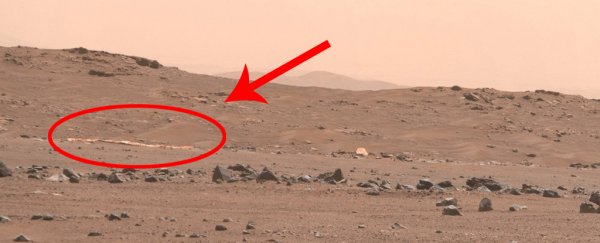More than 13 months after the Perseverance rover landed on Mars (on 18 February 2021), the rover's cameras have finally spotted some of the parts of the Mars 2020 landing system that got the rover safely to the ground.
The parachute and backshell were imaged by Perseverance's MastCam-Z, seen off in the distance, just south of the rover's current location. The image was taken on Sol 404, or 6 April 2022 on Earth.
Normally, the rover might have taken a brief side-trip early on in the mission to take images of the remains of the landing system. But Perseverance had to drive around some hazardous terrain to get to a large area of Jezero Crater that the science team wanted to study, called South Séítah.
That was near the area where the parachute landed, and the rover finally got there. The parachute was jettisoned during the landing sequence so the Skycrane could lower the rover down to the surface on its wheels.
You may recall the parachute included a secret message hidden within the folds and colors of the material.
You can see the traverse map below, and below that is an image taken by the HiRISE camera on the Mars Reconnaissance Orbiter showing the location of the parachute and backshell, along with the rover and other items from the landing. This image was taken a day after Perseverance landed.
![]() Screenshot of Perseverance's location map on Sol 405. (NASA)
Screenshot of Perseverance's location map on Sol 405. (NASA)
 First HiRISE image of Perseverance on Mars. (NASA/JPL/University of Arizona)
First HiRISE image of Perseverance on Mars. (NASA/JPL/University of Arizona)
This HiRISE image of the Perseverance Rover on the surface of Mars also shows the many parts of the descent system. Each inset shows an area about 650 feet (200 meters) across.
The rover itself sits at the center of a blast pattern created by the hovering Skycrane (labeled as "descent stage") that lowered it there. The Skycrane flew off to crash as at a safe distance creating a V-shaped debris pattern.
And now, Perseverance is backtracking to reach the next target location for the mission's second science campaign, an area that looks like a large river delta. The choice to study South Séítah first was a choice the team made knowing they would have to backtrack later to reach the delta.
Perseverance is now in a drive campaign to reach the delta, going faster than any previous rover, although it is only going under a tenth of a mile per hour. Perseverance is using an auto-nav feature to 'make tracks,' and is making comparatively rapid progress by devoting several hours per day to driving on very smooth terrain.
Perseverance has now broken previous rovers' records for the distance traveled in one day by driving 319.8 meters on Sol 351.
Curiosity made a number of drives over 100 meters, but none over 200 meters. That was due in part to rockier terrain. Opportunity, which landed way back in 2004, had some very smooth patches of terrain, allowing it to travel up to 228 meters in one day using solar power just a year after its landing.
You can get the latest news about Perseverance at the team's mission update blog.
This great video by Dr Steve Ruff from Arizona State University explains the landing system and why Perseverance was able to find the various parts now.
This article was originally published by Universe Today. Read the original article.
